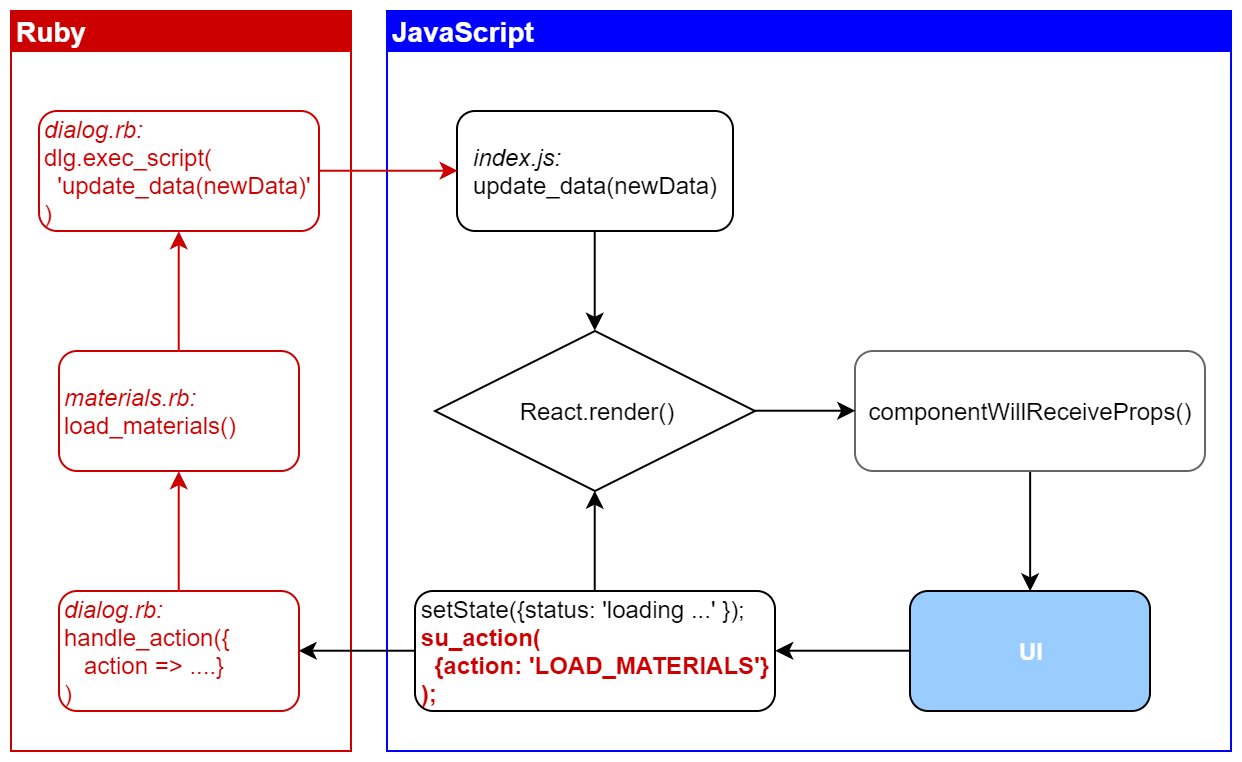« Connecting Ruby and JavaScript Back to Index
Connecting the App
We have established the basics of exchanging data between Ruby and JavaScript. To apply this in our app we have to extend the Ruby callback to process the action sent from the dialog and send the result back as a JSON string. The typical update cycle will look something like this:

- A user interaction triggers a function.
- The function calls
setStateto update the interface with a new state. It also passes an action to the Rubysu_actioncallback that is then sent toprocess_action. process_actionevaluates the type of the action, runs the corresponding Ruby function and creates a response object.dialog.execute_scriptis used to run the JavaScriptupdate_datafunction with the response object as argument.update_datacallsReact.renderwhich passes the new data to the App component as props.data.App.willReceivePropsmerges the new data set with the component state and rebuilds the interface.- A user interaction triggers a function …
Strictly speaking, only the REPLACE_MATERIAL action will be processed in this way. The selection of a material bypasses the Ruby side and just triggers a UI update via setState.
The Ruby Callback
At first we need to extend the Ruby action callback to process the action and return the response object to the dialog.
...
# define 'su_action' callback to be used from JavaScript
dlg.add_action_callback("su_action") { |action_context, action|
self.log_action(action)
response = self.process_action(action)
js_command = 'update_data(' + response.to_json + ')'
dlg.execute_script(js_command)
}
...
Processing the Action
The process_action function will handle all action requests sent from the dialog. It always has to return a valid response object. Therefore we define a simple response first and wrap the processing part in a begin ... end block. The initial response is an error message to signal to the user that something went wrong. If the action processing succeeds the response is redefined with the new data to display in the dialog.
The first action we have to consider is loading the list of materials. The action is identified by the type of LOAD_MATERIALS. The response object contains a status message and the key materials which has a hash of materials as its value. The hash is provided by the get_material_hash function.
In a similar way we can define an action to load the material thumbnails (LOAD_THUMBNAILS).
module SketchupReactDemo
module_function
def process_action(action)
puts 'processing action ...'
# Begin with an error message to flag if something goes wrong.
response = {'error' => 'unknown action type', 'status' => 'ERROR'}
begin
if action['type'] == 'LOAD_MATERIALS'
response = {
'materials' => self.get_material_hash,
'status' => 'materials loaded'
}
end
if action['type'] == 'LOAD_THUMBNAILS' then
response = {
'thumbnails' => self.get_thumbnails_hash,
'status' => 'thumbnails loaded'
}
end
if action['type'] == 'REPLACE_MATERIAL'
# implementation see below
end
# in case of an exception replace the existing error message with
# the exception's error message
rescue => e
puts e
response = {'error' => e, 'status' => 'ERROR'}
end
self.log_response(response)
return response
end
end
To replace a material (action type REPLACE_MATERIAL) we also need to provide the name of the material to replace (replace) and the name of the replacement material (replace_with) in the action payload.
The response for this action will be a new list of model materials (now without the replaced material) which will replace the list that is already loaded in the dialog. To the user the replaced material will simply vanish from the list.
...
if action['type'] == 'REPLACE_MATERIAL'
replace = action['payload']['replace']
replace_with = action['payload']['replace_with']
self.replace_material(replace, replace_with)
response = {
'materials' => self.get_material_hash,
'status' => "replaced '#{replace}' with '#{replace_with}'"
}
end
...
Updating JavaScript Data
In the JavaScript code we have to define the update_data function that can be called via the execute_script method of the dialog instance. This function has to be defined directly on the global object or it will be hidden in a JavaScript closure by the bundler.
The default configuration for the ESLint style checker does not allow global definitions. To avoid errors during the compilation we have to disable this rule with the eslint-disable-next-line comment.
The only action that update_data needs to perform is to rerender the App with the newly provided data. The new data is then available to the component as as props.data.
...
// eslint-disable-next-line
global.update_data = function(newData) {
console.log('=> update_data');
console.log(JSON.stringify(Object.keys(newData), null, 2));
ReactDOM.render(<App data={newData} />, document.getElementById('root'));
}
...
The real update happens in the componentWillReceiveProps which calls the mergeProps function with the existing state and the new data to be merged. The error, materials and status properties are replaced with the new new data objects (if present). The thumbnails object will be updated with the new information which allows us to send individual thumbnails to the dialog. We also don’t need to remove thumbnails that already exist. They will simply not be used.
The object returned from mergeProps will be used to update the component’s state. It does not contain the source and match properties, so the existing selection state is not affected by the update.
...
// replace error, materials and status but update thumbnails
function mergeProps(state, newProps = {}) {
return {
error: newProps.error || '',
materials: newProps.materials || state.materials || {},
status: newProps.status || state.status || '',
thumbnails: Object.assign({}, state.thumbnails, newProps.thumbnails)
};
}
...
With this function we have all the elemnts that are necessary to receive data in JavaScript and update the interface accordingly.